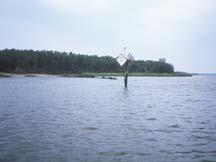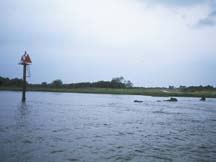Locating sciaenid spawning aggregations in anticipation of harbor modifications, and reactions of spotted sea trout spawners to acoustic disturbance
Mark Collins, Bridget Callahan, Bill Post, and Amanda Avildsen
SC Marine Resources Research Institute, SCDNR, Charleston, SC, USA
The drum family, which includes spotted seatrout, red drum, and other recreationally (= economically) important fishes, spawn in estuaries with males making drumming sounds to attract mates to spawning aggregations. Populations of many of these species have declined in abundance in recent years throughout much of the southeast. Most southern states have responded by tightening harvest regulations. Plans for major modifications and deepening of the Savannah Harbor (GA/SC, USA) and shipping channel have caused fears that this will make the situation worse by interfering with spawning success. It was not known if, or where, these important fishes might spawn in the Savannah River estuary, so a study was conducted to examine the possibility that dredging would cause major problems.
An acoustic survey was conducted during August- November 2000 and February-November 2001 in the Savannah River estuary, with some coverage of the shipping channel offshore. A directional hydrophone, analog receiver, and audio recorder were used to detect and record signals, and specific locations of spawning sites were determined through triangulation. Signal strength, prominent bottom characteristics, light phase, tide stage, current velocity, depth, temperature, salinity, and dissolved oxygen were recorded for each location. Emphasis was on the lower estuary where salinities were >15 ppt, but occasional broader surveys were conducted to ensure that no spawning activity was occurring farther upriver.
During June 2001, preliminary dredging operations began in one turning basin in the lower harbor, which had been identified as the location of one of the primary spawning aggregations of spotted seatrout. The reaction of the spawning aggregation to dredging activity was monitored through the end of the spawning season.
Drumming males of red drum, spotted seatrout, black drum, and weakfish were found. Sporadic drumming of all species occurred in various locations of the lower estuary. However, six primary spawning sites were identified for spotted seatrout, one for weakfish, and one for black drum. All sites were in salinities > 16 ppt, and all were within 12.2 river km of the river mouth. Time of day of spawning varied somewhat among species, but in general it appeared to be anchored around sunset with peak activity from about 1 hr before through about 3 hr after. This was especially evident with spotted seatrout, which had the longest spawning season. As day length shortened and sunset occurred progressively earlier at the end of the summer, spawning activity began earlier.

 |
| Typical
spotted seatrout spawning sites in the Savannah River estuary, SC/GA
(USA). Common characteristics include: salinity greater than 16 ppt.,fast
current, structure (markers, rock jetties), and proximity to deep water (13 m. channel). |
Spotted seatrout spawning activity took place during May-September, peaking in July-August. Water temperature apparently was a seasonal spawning cue, as activity ceased abruptly and did not resume when there was a 2oC drop to 24oC over a 2-day period (although spawning in lower temperatures has been previously reported). All six sites located in 2000 were again used in 2001, but activity did not begin at all sites simultaneously. The sites had several characteristics in common: they were in the main river channel rather than side-creeks, they were in or adjacent to deep water (7-10 m), and they were associated with structure of some type. Structure varied among sites, but was generally a large channel marker or a rocky area such as a submerged jetty. Drumming activity appeared strongest when a high or early ebb tide occurred during the appropriate time of day.
Black drum spawned during late March to mid-June at river km 0 (the river mouth) in water temperatures of 14-19oC. Weakfish spawning activity was concentrated just upriver at river km 2 during June to early October at temperatures of 23.9-29.0oC. Weakfish appeared to be less site-specific than black drum or spotted seatrout, with the aggregation sometimes moving about somewhat. Weakfish also tended to aggregate around structure like spotted seatrout, although more weakly, while black drum aggregated in the middle of the channel where no structure could be detected.
No large red drum spawning aggregations were located. A number of times, individuals or very small groups of drumming males were found. This was most consistently at the mouth of the river and in the shipping channel outside the mouth. All activity noted was during August-September.
The active dredge in the vicinity of a large spotted seatrout aggregation began operations at the upriver end of the turning basin, the opposite end from the aggregation, and moved slowly downriver. No changes in drumming intensity or periodicity relative to the dredge were noted. However, the spawning season ended (as confirmed by checking other known spawning sites) before the dredge actually reached the fish; it was ~100 m away at that point. Large and small vessels transited the area but did not disturb the fish. One acoustic disturbance that was dramatically apparent, however, was a total cessation of drumming when bottlenose dolphin (which make a pronounced acoustic signal) passed by. This behavior was also noticed on two occasions with red drum.
Passive acoustic mapping of drum spawning sites in preparation for harbor modifications was successful. It confirmed spawning of important species within the harbor area, and it defined the spawning temporally and spatially. There was considerable temporal overlap in spawning activity among species, and in the lower 2 river km there appeared to be spatial overlap. However, on a finer scale (hundreds of meters) there was little or no overlap. It is obvious, however, that the lower 2 river km can be considered the most important sciaenid spawning area in the Savannah estuary, as all four species aggregated in that stretch of river. Aggregations of red drum were very small. Comparing this behavior to previous reports from the region is problematic due to the limited number of systems that have been studied; the aggregation in Charleston Harbor, SC was quite large, while the aggregation detected in St. Helena Sound, SC was very small. Thus, it is not known whether red drum typically form large aggregations in this region, or if in some systems they generally spawn in small groups.
Despite the apparent importance of acoustic signals in spawning aggregations for these species, noise from boats, dredges, etc. did not interfere with drumming behavior, even when the source of the noise was close by. Certainly, these fish must be acclimated to vessel passage due to the fact that the Savannah River is a major port. It is unknown whether fish in a less populous habitat would be so impervious to noise. The only response to an acoustic signal was exhibited toward bottlenose dolphin, which prey on these fishes; the cessation of drumming was apparently a predator avoidance behavior.
While spotted seatrout males do not respond to dredging noise, it is unknown what effect a dredge would have as it worked in the midst of the aggregation. Relatively large fishes (e.g., juvenile Atlantic sturgeon ) are reported with some regularity having been sucked up by dredges elsewhere. Further, because two (and possibly three) of these species appear to cue in on structures, removal of these structures, as commonly occurs during deepening and channelization operations, may have a negative impact. Future research plans include statistical analyses of environmental variables as related to drumming activity, and re-examination in 2002 of spotted seatrout spawning behavior in the turning basin that was dredged in 2001.
Acknowledgments
Hayne von Kolnitz assisted extensively in both field and laboratory. Bruce Stender verified identifications of larval fishes. Joseph Luczkovich (East Carolina University), Mark Spraque (East Carolina University), Archibald McCallum (University of Charleston), Grant Gilmore (Dynamac Corp.), and Bill Roumillat provided invaluable assistance in verifying species identifications from acoustic recordings of aggregations. South Carolina Department of Natural Resources, Georgia Ports Authority, and Southern Liquid Natural Gas provided funding.